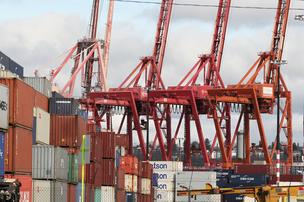Fine-Tuning Your Warehouse Layout
Developing an efficient and safe warehouse can be challenging. Here is some advice from Walt Swietlik, director of customer relations and sales support for loading dock equipment company Rite-Hite.
1. Know your business requirements. Before you design your facility, examine your books. The data will show you what to expect in terms of stock turns, returns, and volume, which is the starting point for determining the size of the warehouse, the storage capacity required, and the number of dock stations needed.
2. Be prepared for an onslaught of intermodal traffic. Look at the length and type of trailers coming in and out of your warehouse, and pay attention to whether or not intermodal traffic is increasing. Intermodal chassis are often a different height than standard trailers and may have an obstructed rear impact guard. It is important to make sure docks and restraints can accommodate both.
3. Allow extra space in the receiving area. The receiving area is one of the most important parts of the warehouse, and is often a hive of cross-docking activity. Working in a cramped space can cause injuries, and other profit-sapping mishaps.
4. Don't make interior doors too big. Why waste energy? Don't make your facility's doors any larger than they have to be—particularly in cooler or freezer areas. If you occasionally need a larger opening, put one larger door into your layout and keep the others smaller.
5. Design safety in from the start. You don't need to decide between safety and efficiency—they can go hand in hand. Make sure safety signage is always visible, but don't rely on it alone. Provide foolproof products and processes such as impactable doors or interlocked dock controls.
6. Ensure the yard supports the warehouse. Warehouses require schedules for inbound and outbound shipments. Congestion outside the warehouse, caused by parking area constraints, will affect these activities. It is important to understand the capacity of your yard to avoid potential bottlenecks.
7. Separate pedestrian and forklift traffic. Signs and painted lines aren't enough. About 110,000 forklift accidents occur each year, many involving pedestrians, according to OSHA. Physical barriers, both permanent and temporary, keep pedestrian and forklift traffic apart.
8. "Button up" your dock stations. Seals, shelters, and doors prevent contaminants from entering the building. A seal around dock stations saves energy, protects cargo, provides employee comfort, and improves the bottom line. Food manufacturers may consider vertical levelers in a "drive-thru" application. This allows trailer doors to remain closed until the trailer is positioned at the loading dock, providing an uninterrupted cold chain and additional level of security.
9. Take advantage of mezzanine opportunities. When a warehouse's physical footprint is limited, it can be expanded upward using mezzanines to add capacity. New forklift technology and safety equipment designed specifically for elevated platforms—such as reciprocating barriers that can't be open in both directions at the same time—make mezzanines a better and safer bet.
10. Protect your cargo from tampering. Trailers at the dock become an extension of your warehouse, so be sure to consider cargo security issues. Use interlocked controls that sense external tampering, and implement restraints that automatically "re-fire" if they lose proper engagement with the trailer's rig.




